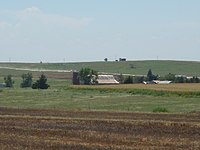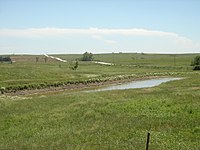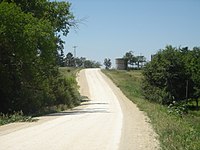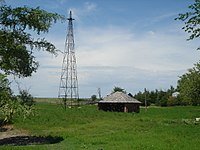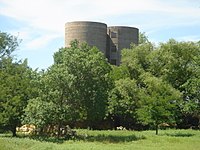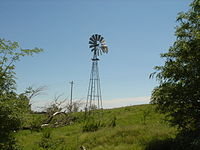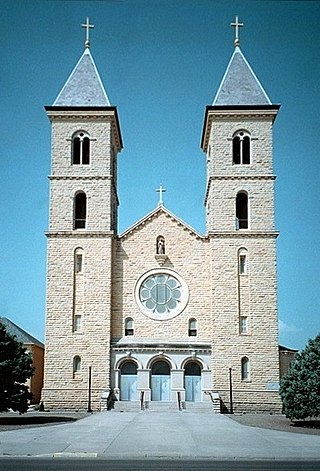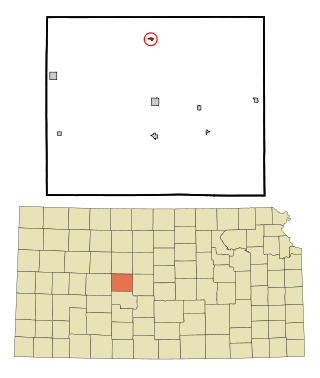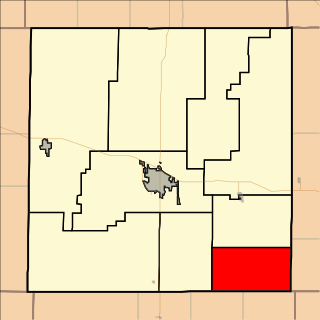Ellis County was established by an act of the state legislature on 1873-02-16, which defined the original borders of the county as:
Independent county government was established in October 1867, by proclamation of Governor Samuel J. Crawford in response to a petition. Hays was chosen as the permanent seat by an election in April 1870. Early settlers the Lull brothers, from Salina, had in May 1867 begun a town called Rome just north of the railroad route and on the west of Big Creek, expecting that to become the county seat. It gained a general supply store, Bloomfield, Moses & Co, the following month, and a hotel run by Joseph Perry. However, the Big Creek Land Company platted a competing town named Hays City on the east of Big Creek, which gained the important support of the railroad company. Rome disappeared, with Perry's hotel and several other of its buildings being relocated to Hays City.
English and Russian-German immigrants
The initial wave of settlement was slow, with three colonies being established in 1872. George Grant, a wealthy Scottish merchant, purchased 70,000 acres (28,000 ha) of land that year, and some 300 farmers from England settled there over the next two years. Grant bought the land from the Kansas Pacific Railroad with the intention of creating a community of British aristocrats and agriculturalists in the middle of rural Kansas. His first town was Victoria named after Queen Victoria where Victoria Manor, a two story stone structure, acted as temporary housing for the immigrants and as a transport depot for the Kansas Pacific. His sales pitch to the immigrants was that it was cheaper to buy land in Kansas at US$11(equivalent to $80.12 in 2023) per acre (Grant himself having purchased it at US$0.88(equivalent to $6.41 in 2023) per acre) than it was to buy land in Britain, and that Grant would till the land and seed it with imported British stock.
The first wave of young British aristocrat families set sail on 1873-04-01. Stories of the time recorded them as not becoming agriculturalists, as Grant had hoped, but mainly indulging in aristocratic pursuits whilst living off family remittances, including hunting the local wildlife. Another story recounts them placing a dam across Big Creek to make a lake between Victoria and Hays which they then sailed across in a steamboat until the dam was broken by a flood; although at the time of the Ellis county centennial in the 1970s one local resident expressed doubts at the historical veracity of this tale, considering the geography of Big Creek in that area.
However, whilst Grant himself put in great effort to start the colony, including importing Black Angus cattle and running his own cattle farm to the south of Victoria, he died in 1878 and after his death all of the British aristocrats had returned to Britain. A plague of grasshoppers in 1874 drove many away, to be replaced in 1875 by many Russian immigrants.
The Russian immigrants were, more strictly speaking, Volga Germans who had settled in Russia in 1760. The Russification policies begun in 1871 by Alexander II, and especially the 1874-01-13 reversal of the original decree that had exempted them from conscription into the Russian military when they had settled in Russia in the first place, prompted them to look to the United States and elsewhere.
Originally five delegates went on a ten day exploratory mission to Nebraska. Later in December 1874, a four-person delegation went to Topeka and Larned in Kansas, reporting unfavourably on what they found. However, in the meantime the first Germans had been conscripted in November 1874, spurring many to emigrate anyway, which they did arriving in Baltimore on 1875-11-23 and in Topeka on the 28th. Initially deterred from homesteading by the US$5(equivalent to $28.31 in 2023) per acre price of land in North Topeka, they were escorted on three tours of Ellis county by A. Roedelheiner of the Kansas Pacific.
Their initial tour of land around Hog Back almost persuaded the immigrants to return to Russia, but they were shown further land on the Smoky Hill River and near what was to become Catherine and Herzog. This Ellis land was cheaper at US$2.5(equivalent to $71.53 in 2023) per acre, and so on 1876-02-21 fourteen German families came to Hays and from there moved to Liebenthal in Rush County. Three families from Katherinenstadt in Russia also came to Hays on 1876-03-01 and, whilst temporarily renting accommodation therein, built their homes in Catherine to which they moved on 1876-04-08.
Twenty-three families settled in the failing British colony at Victoria on 1876-04-08, settling on the east bank of Victoria Creek just west of where Victoria now exists. Another large wave of immigrants left Russia in June 1876, and some of them arrived in Hays on 1876-07-26 and in Catherine the next day. Others took a different route and arrived and settled in Topeka. Thirteen of the families arrived in Hays on 1876-08-20 and settled in Pfeifer the next day.
One of the largest wave of immigrants was 104 families (originally to be 108, but 4 had been held back because family members had been conscripted, which legally prevented them from emigrating from Russia) in 1876. The Mennonites in the group settled in Nebraska, with the others arrived in Victoria on 1876-08-03 and from there settled in Herzog. The settlers of Munjor stayed in Herzog for two months, before settling on Big Creek just north of the present location of Munjor.
A small wave of immigrants followed the first wave to Pfeifer in late September 1876, with another small wave from Katherinenstadt arriving in Catherine on 1876-09-26. The last 1876 wave of immigrants settled in Munjor.
The German immigrants founded Schoenchen in 1877, some coming directly from Schoenchen in Russia, some coming from Liebenthal in Rush County. Their original plan had been to move from Liebenthal to another site in Rush, but the place that they had chosen was school land that they could not afford, meaning that they could not deed enough of it to the community to erect their church, whilst at the same time land for a church had been deeded in Liebenthal. In recrimination, the Rush county settlers moved to Ellis, joining the direct immigrant party at Schoenchen in April and May 1877. Two other small waves came that year, one to Catherine on 1877-08-06 from Katherinenstadt, and one to Pfiefer from Pfiefer and Kamenka in Russia.
Immigration began to wane in 1878, with a party from Katherinenstadt arriving on 1878-06-20 to settle in Herzog and Pfeifer, and another party from Obermonjour in late July/early August. By this point, property prices had been depressed back in Russia by all of the sales made by the preceding emigrants, and further emigrants were now emigrating at a net loss. Another party, having had to cover the Russian emigration fees through deceit, claiming that two of their number had died to officials who only dealt with the two people who left the train, since the party collectively had not enough money for all even though they had pooled their funds, arrived in Herzog and Munjor and was the last large wave of Volga German immigrants to Ellis.
By 1903, there had been 222 immigrants to Catherine, some going thence elsewhere. Munjor grew from 130 families, 794 people, in 1897 to 156 families, 931 people, by 1900. The largest of the Volga German settlements was Herzog, having roughly 1700 people (measured from church congregation size as accounted in the Victoria Chronicle) in 1895, with Pfeifer and Schoenchen coming fourth and fifth.






